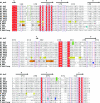CD46 is a cellular receptor for all species B adenoviruses except types 3 and 7
- PMID: 16254377
- PMCID: PMC1280233
- DOI: 10.1128/JVI.79.22.14429-14436.2005
CD46 is a cellular receptor for all species B adenoviruses except types 3 and 7
Abstract
The 51 human adenovirus serotypes are divided into six species (A to F). Adenovirus serotypes from all species except species B utilize the coxsackie-adenovirus receptor for attachment to host cells in vitro. Species B adenoviruses primarily cause ocular and respiratory tract infections, but certain serotypes are also associated with renal disease. We have previously demonstrated that adenovirus type 11 (species B) uses CD46 (membrane cofactor protein) as a cellular receptor instead of the coxsackie-adenovirus receptor (A. Segerman et al., J. Virol. 77:9183-9191, 2003). In the present study, we found that transfection with human CD46 cDNA rendered poorly permissive Chinese hamster ovary cells more permissive to infection by all species B adenovirus serotypes except adenovirus types 3 and 7. Moreover, rabbit antiserum against human CD46 blocked or efficiently inhibited all species B serotypes except adenovirus types 3 and 7 from infecting human A549 cells. We also sequenced the gene encoding the fiber protein of adenovirus type 50 (species B) and compared it with the corresponding amino acid sequences from selected serotypes, including all other serotypes of species B. From the results obtained, we conclude that CD46 is a major cellular receptor on A549 cells for all species B adenoviruses except types 3 and 7.
Figures






Similar articles
-
Adenovirus type 11 uses CD46 as a cellular receptor.J Virol. 2003 Sep;77(17):9183-91. doi: 10.1128/jvi.77.17.9183-9191.2003. J Virol. 2003. PMID: 12915534 Free PMC article.
-
CD46 is a cellular receptor for group B adenoviruses.Nat Med. 2003 Nov;9(11):1408-12. doi: 10.1038/nm952. Epub 2003 Oct 19. Nat Med. 2003. PMID: 14566335
-
The Arg279Gln [corrected] substitution in the adenovirus type 11p (Ad11p) fiber knob abolishes EDTA-resistant binding to A549 and CHO-CD46 cells, converting the phenotype to that of Ad7p.J Virol. 2006 Feb;80(4):1897-905. doi: 10.1128/JVI.80.4.1897-1905.2006. J Virol. 2006. PMID: 16439545 Free PMC article.
-
[Cell receptors for human adenoviruses].J Soc Biol. 1999;193(1):77-84. J Soc Biol. 1999. PMID: 10851559 Review. French.
-
What does it take to bind CAR?Mol Ther. 2005 Oct;12(4):599-609. doi: 10.1016/j.ymthe.2005.05.017. Mol Ther. 2005. PMID: 16109509 Review.
Cited by
-
Oncolytic viruses: the power of directed evolution.Adv Virol. 2012;2012:586389. doi: 10.1155/2012/586389. Epub 2011 Jul 24. Adv Virol. 2012. PMID: 22312363 Free PMC article.
-
Characterization of a novel species of adenovirus from Japanese microbat and role of CXADR as its entry factor.Sci Rep. 2019 Jan 24;9(1):573. doi: 10.1038/s41598-018-37224-z. Sci Rep. 2019. PMID: 30679679 Free PMC article.
-
Adenovirus flow in host cell networks.Open Biol. 2019 Feb 28;9(2):190012. doi: 10.1098/rsob.190012. Open Biol. 2019. PMID: 30958097 Free PMC article. Review.
-
Ligation of CD46 to CD40 inhibits CD40 signaling in B cells.Int Immunol. 2011 Mar;23(3):215-21. doi: 10.1093/intimm/dxq474. Int Immunol. 2011. PMID: 21393637 Free PMC article.
-
Glycomics and Proteomics Approaches to Investigate Early Adenovirus-Host Cell Interactions.J Mol Biol. 2018 Jun 22;430(13):1863-1882. doi: 10.1016/j.jmb.2018.04.039. Epub 2018 May 7. J Mol Biol. 2018. PMID: 29746851 Free PMC article. Review.
References
-
- Adrian, T., G. Wadell, J. C. Hierholzer, and R. Wigand. 1986. DNA restriction analysis of adenovirus prototypes 1 to 41. Arch. Virol. 91:277-290. - PubMed
-
- Arnberg, N., A. H. Kidd, K. Edlund, J. Nilsson, P. Pring-Åkerblom, and G. Wadell. 2002. Adenovirus type 37 binds to cell surface sialic acid through a charge-dependent interaction. Virology 302:33-43. - PubMed
-
- Arnberg, N., Y. Mei, and G. Wadell. 1997. Fiber genes of adenoviruses with tropism for the eye and the genital tract. Virology 227:239-244. - PubMed
Publication types
MeSH terms
Substances
LinkOut - more resources
Full Text Sources
Other Literature Sources
Molecular Biology Databases

